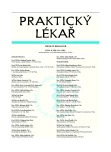Evolution and evolutionary theory for physicians.
VIII. Evolution of the human brain
Authors:
F. Koukolík
Authors‘ workplace:
Primář: MUDr. František Koukolík, DrSc.
; Národní referenční laboratoř prionových chorob
; Fakultní Thomayerova nemocnice s poliklinikou, Praha
; Oddělení patologie a molekulární medicíny
Published in:
Prakt. Lék. 2010; 90(8): 451-454
Category:
Editorial
Overview
Until recently hominids could only be studied by means of paleoanthropology. Population genetics and molecular biology play an ever larger role today. The anatomical evolution of the brain describes a tenfold enlargment of the number of cortical brain areas during the evolution of mammals – from about 20 to 200. The molecular evolution of the brain records selection of adaptive mutations of a number of genes. Regulation of their expression is more significant however. According the social brain hypothesis, the complexity of social relationships was the fundamental selection pressure that lead to enlargment of brain volume in evolutionary ancestry in early man.
Key words:
Hominids, social brain hypothesis, brain, anatomical evolution, molecular evolution.
Sources
1. Aiello, L.C., Dean, C. An introduction to human evolutionary anatomy. London: Academic Press, 1990.
2. Bailey, D.H., Geary, D.C. Hominid brain evolution. Hum. Nat. 2009, 20, p. 67-79.
3. Berger, L.R., de Ruiter, D.J., Churchill, S.E. et al. Australopithecus sediba: a new species of Homo-like Australopith from South Africa. Science 2010, 328, p. 195-204.
4. Bradley, B.J. Reconstructing phylogenies and phenotypes: a molecular view of human evolution. J. Anat. 2008, 212, p. 337-353.
5. Brown, P., Sutikna, T., Morwood, M.J. et al. A new small-bodied hominin form late pleistocene of Flores, Indonesia. Nature 2004, 431, p. 1055-1061.
6. Burki, F., Kaessmann, H. Birth and adaptive evolution of a hominoid gene that supports high neurotransmitter flux. Nat. Genet. 2004, 36, p. 1061-1063.
7. Creely, H., Khaitovich, P. Human brain evolution. Prog. Brain Res. 2006, 158, p. 295-309.
8. Dirks, P.H.G.M., Kibii, J.M., Kuhn, B.F. et al. Geological setting and age of Australopithecus sediba from southern Africa. Science 2010, 328, p. 205-208.
9. Dunbar, R.I.M., Shultz, S. Evolution in the social brain. Science 2007, 317, p. 1344-1347.
10. Frazer, K.A., Ballinger, D.G., Cox, D.R. et al. A second generation of human haplotyp map of over 3.1 million SNPs. Nature 2007, 449, p. 851-861.
11. Gilad, Y., Rosenberg, S., Przeworski, M. et al. Evidence for positive selection and population structure at the human MAO-A gene. Proc. Natl. Acad. Sci. USA 2002, 99, p. 862-867.
12. Green, R.E., Krause, J., Briggs, A.W. et al. A draft sequence of the neandertal genome. Science 2010, 328, p. 710-722.
13. Grehan, J.R., Schwarz, J.H. Evolution of the second orangutan: phylogeny and biogeography of hominid origins. J. Biogeogr. 2009, 36, p. 1823-1844.
14. Holloway, R.L. The human brain evolving: a personal perspectives. Annu. Rev. Anthropol. 2000, 37, p. 1-19.
15. Cherry, M. Claim over „human ancestor“ sparks furore. Nature news 2010, doi:10.1038/news. 2010.171.
16. Johnson, M.B., Kawasawa, Y.I., Mason, Ch.E. et al. Functional and evolutionary insights into brain development through global transcriptome analysis. Neuron 2009, 62, p. 494-509.
17. Kaas, J.H. The evolution of the complex sensory and motor systems of the human brain Brain, Res. Bull. 2008, 75, p. 384-390.
18. Khaitovich, P., Muetzel, B., She, X. et al. Regional pattern of gene expression in human and chimpanzee brains. Genome Res. 2004, 14, p. 1462-1473.
19. Kimura, M. The neutral theory of molecular evolution. Cambridge: Cambridge University Press, 1983.
20. Koukolík, F. Sociální mozek. Praha: Karolinum, 2006.
21. Koukolík, F. Lidství. Neuronální podklady. Praha: Galén, 2010.
22. Koukolík, F. Funkční systémy lidského mozku. Praha: Galén, 2011 ( v tisku), kapitola Lateralita.
23. Krause, J., Fu, Q., Good, J.M. et al. The complete mitochondrial DNA genome of an unknown hominin from south Siberia. Nature 2010, doi:10.1038/nature08976.
24. Leakey, M.G., Spoor, F., Brown, F.H. et al. New hominin genus from eastern Africa shows diverse middle Pliocene lineages. Nature 2001, 410, p. 433-440.
25. Robson, S.L., Wood, B. Hominin life history: reconstruction and evolution. J. Anat. 2008, 212, p. 394-425.
26. Stedman,H.H., Kozyak, B.W., Nelson, A. et al. Myosin gene mutation correlates with anatomical changes in the human lineage. Nature 2004, 428, p. 415-418.
27. Vallender, E.J. Exploring the origins of the human brain through molecular evolution. Brain Behav. Evol. 2008, 72, p. 168-177.
28. Vargha-Khadem, F., Ghadian, D.G., Copp, A. et al. FOXP2 and the neuroanatomy of speech and language. Nat. Rev. Neurosci. 2005, 6, p. 131-138.
29. White, T.D., Asfaw, B., Beyene, Y. et al. Ardipithecus ramidus and the paleobiology of early hominids. Science 2009, 326, p. 75-86.
30. Wood, B., Collard, M. The human genus. Science1999, 284, p. 65-71.
31. Wood, B., Lonegan, N. The hominin fossil record: taxa, grades and clades. J. Anat 2008, 212, p. 354-376.
Labels
General practitioner for children and adolescents General practitioner for adultsArticle was published in
General Practitioner

2010 Issue 8
Most read in this issue
- Spontaneous intracranial hypotension
- Zinc and its relation to prostate tumours
- Human biomonitoring – its importance and application for evaluating population exposure to environmental chemicals (toxins)
- Physical activity as a part of cardiovascular disease prevention in the general practitioner’s surgery
